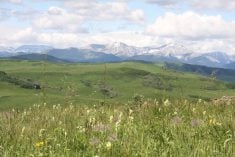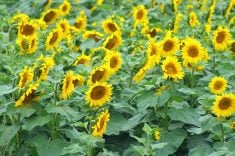Fertilizer sticker shock is persuading more farmers to grow soybeans this year, but they can’t forget about phosphorus.
With nitrogen prices through the roof, prairie producers who haven’t grown soybeans before are choosing them in hopes of finding a new profitable crop and avoiding a high fertilizer bill.
“If you have the moisture, and you grow a variety that meets your needs when it comes to heat units, the crop can do very well in Western Canada,” said Brent Reid of Manitoba Agriculture.
Rigas Karamanos of Westco Fertilizers in Calgary said while the crop can fix its own nitrogen with a little help from producer-supplied bacteria, it still needs its share of phosphorus.
Read Also

Gene editing digs deeper space in Canadian plant breeding
More Canadian research into crop variety development is incorporating gene editing, and one researcher notes that Canada’s regulatory approach to gene editing will help drive innovation
“You need to inoculate to get that N. These crops use a lot of nitrogen, but they produce it for themselves provided they are inoculated (with a nitrogen fixing bacteria),” he said.
“But you won’t get the yields unless there is enough P to meet the crop’s needs.”
Reid said with phosphorus prices above $1,400 per tonne, many producers would also like to reduce that cost.
“Last year farmers were asking how much phosphorous they could apply with soybean seeds without hurting germination. This year the question has been how little can they get away with,” he said.
“It’s a complicated question.”
Soybeans require about 0.9 pounds of phosphorus to produce a bushel of beans. A 50 bu. crop needs about 45 lb. of fertilizer.
Unlike nitrogen, phosphorus doesn’t tend to boost yields in a relatively straight trend line as the amount applied or available to the crop increases.
“It starts with a soil test,” Reid said.
The results from a phosphorus soil test should be in broad categories: low, zero to 10 parts per million; medium, 10 to 15 ppm and high, above 15 ppm.
“If your soil scored low, then cutting your P rates from what is recommended will generally result in reduced yields,” he said.
“With commodity prices where they are, that might not be such a good idea, despite very high phosphorous costs.”
Reid said the chances of getting an economically positive response from a medium level of phosphorus in the soil – 10 to 15 ppm – will happen 56 percent of the time on average.
Adding the recommended amount of phosphorus per acre on land that already has 15 ppm or more will deliver a bonus only 29 percent of the time.
“You don’t want to skimp on P in low testing soils, especially when the soil temperature is as cold as it has been.”
Reid recommended a seed row placing of no more than 10 lb. per acre, especially in dry conditions.
“You could push that a little if it is wet in a low testing field, especially with a sweep,” he said.
The best place to cut phosphorus rates is on fields testing 13 ppm or more. Warmer soil temperatures improve phosphorus scavenging and reduce the amount that needs to be applied.
“As expensive as it is, P is necessary, and if the soil is deficient, despite the price, the investment will be worth it,” Reid said.














